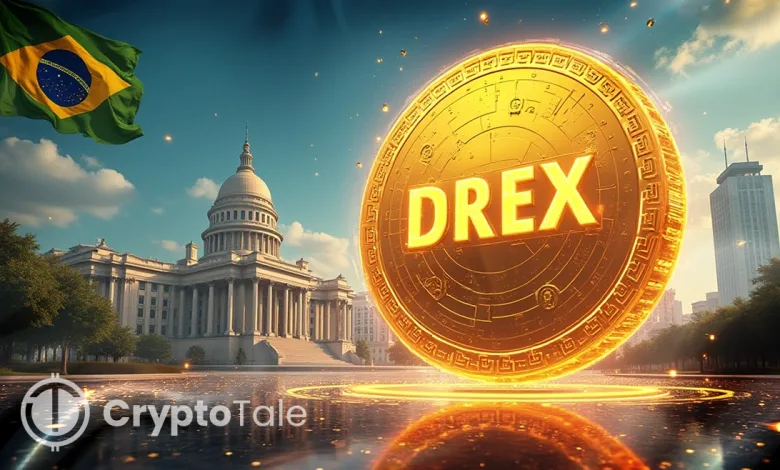Brazil Fast-Tracks Drex CBDC for 2026 Without Blockchain

- Brazil will launch the first phase of Drex in 2026 with a centralized system only.
- Blockchain integration will be reviewed in the second phase when privacy tools improve.
- The centralized model will include lien reconciliation to support new credit operations.
Brazil’s central bank plans to launch its central bank digital currency, Drex, in 2026 using a centralized model without blockchain elements. According to local media reports, the decision follows concerns over the technical maturity and privacy readiness of blockchain solutions tested during the pilot phases.
Central Bank Confirms Phased Rollout
Fabio Araujo, coordinator of the Drex project at the central bank, confirmed that Drex will be delivered in two phases. The first phase will not include decentralized aspects and is expected to begin in 2026. The second phase will aim to integrate blockchain technology once it meets the required standards for security and compliance.
The shift means that many use cases tested in the pilot will not be implemented initially. The centralized architecture will limit programmability compared to blockchain-based models. The central bank has also not guaranteed the continued use of Hyperledger Besu, the Ethereum-compatible platform initially chosen for Drex in 2023.
Technical Challenges and Privacy Concerns
Araujo explained that while promising privacy solutions were presented for the decentralized version, they are still inadequate for Brazil’s financial system. Speaking to Valor Econômico, he said, “We find good privacy solutions, but apparently they’re not enough. We need to put this to the test.”
Privacy challenges have hindered Drex’s decentralized ambitions since 2024, when the central bank delayed the pilot due to the inefficiency of proposed privacy solutions. These lacked the ability to offer bank-transaction-level secrecy and verifiability.
The first phase will instead focus on delivering a lien reconciliation solution to support credit operations with various forms of collateral. The tools for this functionality have yet to be disclosed.
Future Features and Strategic Impact
While blockchain will not feature in the initial phase, Drex continues to explore programmable money capabilities. These include smart contracts and conditional payments that could enable advanced services like time-based or condition-based transfers.
Proponents say such innovations could help modernize Brazil’s financial system and enhance operational efficiency. Some believe these features could strengthen the country’s position in the global CBDC landscape. However, not all policymakers support related crypto initiatives. Nilton David, the central bank’s director of monetary policy, has stated that including crypto assets in Brazil’s foreign exchange reserves would be inappropriate.
The redesigned Drex strategy aligns with a broader global trend where central banks pursue practical, scalable solutions before adopting more complex technologies. Brazil’s model will operate as a two-tier system. The central bank will issue the currency, and commercial banks will manage distribution to the public.
Related: Brazil’s VERT Launches $130M Tokenized Credit on XRP Ledger
Brazil’s Expanding Digital Finance Landscape
Brazil already holds a leading position in Latin America’s crypto market. It has approved several spot cryptocurrency ETFs, including products like FOMO11, DEFI11, and HASH11. In August 2024, Brazil also approved a Solana [SOL] spot ETF, expanding investment options for digital assets.
With Drex’s centralized rollout in 2026, Brazil aims to deliver a functional CBDC quickly while leaving room to integrate advanced blockchain features in the future. This strategy reflects a deliberate, research-driven posture that emphasizes delivering core payment and credit capabilities first, while reserving blockchain and enhanced privacy features for a later phase when they are more mature and compliant. Could this pragmatic approach influence how other nations structure their CBDC programs?




